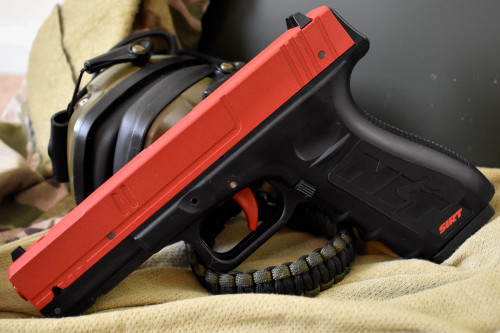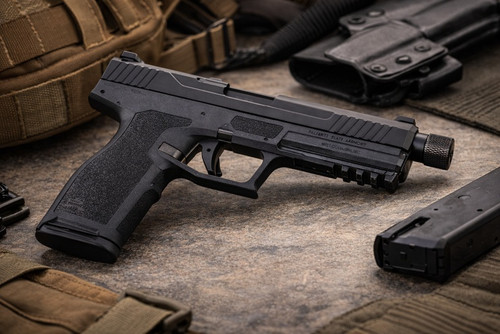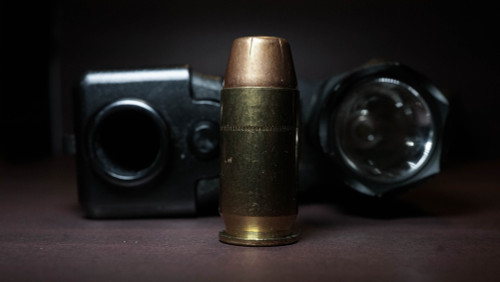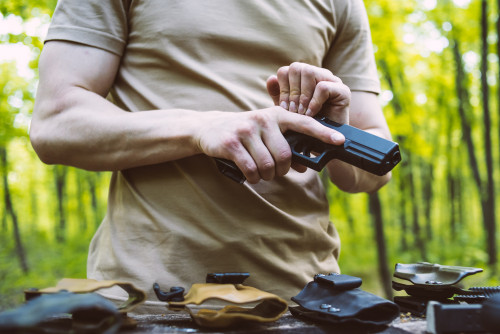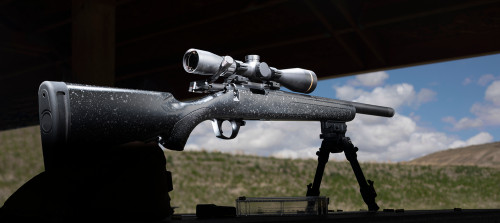Carrying a gun doesn’t mean you’re well-armed. To react effectively in the chaos of a gunfight, your shooting skills must be automatic and reflexive. Under extreme stress, you will not magically become James Bond — you will default to the level of your training.
But training requires expensive ammo, long hours spent at the range, and expert coaching, right? Yes and no. While true proficiency requires live fire range time, there’s a lot you can learn on your own strictly through dry fire training — no ammo or range trips required.
Dry fire training allows you to use your own guns to train in the comfort of your own home — without putting a ton of holes in the wall. If you’re familiar with this concept, you’ve likely heard of dry fire training systems like MantisX and SIRT. But are these systems really worth the hype?
Let’s take an in-depth look at some of the best dry fire training systems available on the market as well as the benefits and limitations of dry fire training.
What is Dry Fire Training?
To put it simply, dry fire training means practicing shooting skills without actually firing live ammo.
To do this, you’ll first need to make sure your weapon is completely unloaded (no magazine and no ammo in the chamber). Once you are absolutely sure there is nothing in your gun, you can effectively press through the trigger without ammunition. This will engage the sear, often causing the hammer to drop (depending on the model of gun). This simulates the action of firing without the bang or the live projectile.
The goal of dry fire training is to develop and reinforce the fundamental abilities you’ll need when you’re on the range or in a real-life encounter. As an analogy, consider a boxer. Like shooting, boxing is composed of a specific set of clearly defined physical and neurological skills that can be developed in a controlled environment and drilled into muscle memory. No good coach is going to throw a brand-new boxer into the ring to just figure it all out — it’s too difficult and dangerous. Instead, a variety of training elements are used to develop the conditioning, reflexes, and fundamental skills needed by the fighter. Only then will the coach allow the boxer to test those skills in the dynamic, adrenaline-fueled environment of a live fight.
Going to the range is like sparring — the cost is too high to use it for basic skill development. Instead, you should develop your skills with solo dry fire training, then express and refine those skills at the range.
Dry Fire Training Drills
There are several routines, maneuvers, and techniques you can practice with dry firing. For example, you can practice drawing your gun, acquiring a sight picture, and pressing through the trigger.
Practice this standing, sitting, and lying on the ground. Practice with both your strong and your weak hand, in low light, and while moving around. Even just a few reps per day add up over time, and you’ll need thousands to make these actions automatic — a key requirement for real-world application under stress.
Plus, all of these skills can be enhanced with technological solutions, which we will get to below.
Why Use Technology-Enhanced Dry Fire Training Solutions?
There are several technological solutions on the market today, designed to enhance realism so we can get the most out of our dry fire training experience. Here are some of the benefits of using dry fire training systems:
- Supplemental coaching: If you lack the time or resources for professional instruction, a training system is the next best thing. Many systems provide diagnostics and feedback to help you improve — similar to the feedback you might get from a coach.
- Leverage mobile power: You have a super computer in your pocket. It only makes sense to apply this technology to improve your shooting. Mobile devices help us track and analyze data to learn about aspects of our shooting that might not be obvious.
- Gamified skill development: If you like your training, you’re more likely to actually do it. Dry fire systems gamify the shooting development process to make it more fun and engaging, which improves training adherence. Every advantage helps.
- Cost-effective: These systems can be pricey upfront, but it’s important to consider the long-term value. If you’re comparing it to ammo cost, it could pay for itself in one or two trips to the range.
Our Top Picks: The 5 Best Dry Fire Training Systems
The dry fire training system market has a wide variety of options available. While this list is far from complete, it gives you a good general idea of how technology has been applied to the problem and what solutions are available right now.
Choosing the right dry fire system will depend on several factors, such as your goals, current skill level, access to coaching, etc. Here’s a quick list of our favorites:
- Mantis X10 Elite: Best for fundamental skill development and diagnostic feedback
- CoolFire Trainer: Best for grip development and recoil management
- Strikeman Laser Firearm Training System: Best for accuracy development
- iTarget Cube: Best for dynamic accuracy and tactical development
- SIRT Pistol: Best for realistic force-on-force scenarios
If you can afford it, you could benefit from including all these systems in your training arsenal. Some can even be combined, such as the Mantis X10 and the CoolFire Trainer, a perfect symbiotic pair.
But before you spend a dime on any fancy technology, make sure you’ve learned all you can with normal dry firing. Let’s take a closer look at each of these.
1. Mantis X10 Elite
The Mantis X10 Elite tracks gun movement data related to aim, trigger pull, and overall handling, which is then sent to your smartphone for analysis. According to Mantis, 94% of shooters improve after just 20 minutes of use.
The Mantis app tracks your progress, identifies patterns, analyzes mistakes, offers coaching advice, and provides 100+ training drills to hone your skills. This basically turns training into a game, which makes the process much more fun and engaging.
This device can be attached to the accessory rail of any pistol, rifle, or shotgun. If your gun doesn’t have a rail, Mantis offers adapters as well. Also, the device is Bluetooth compatible and can operate for eight or more hours on a single charge.
The Mantis dry fire training system can track data during both dry and live fire, making it a valuable piece of shooting technology — especially if you are learning on your own.
Key Features
- Real-time movement feedback and analysis
- Tailored coaching
- Use with live or dry fire training
- Use in conjunction with other training systems
Limitations
- No recoil or trigger reset with base model
BONUS: Mantix Blackbeard/Blackbeard X
Mantis has also released a dry-fire training system specifically designed for AR-15 and Sig Sauer MCX owners. It’s called the Blackbeard. Featuring an auto-resetting trigger that mimics a real trigger pull, it makes dry fire reps more realistic.
The newest model, BlackbeardX, combines all the things that make the Blackbeard great while also using the technology enhancements from the MantisX system. This version allows you to simulate high-engagement combat and thoroughly analyze your shooting based on motion sensor data.
2. CoolFire Trainer
Perhaps the biggest problem with standard dry fire training is the lack of recoil — an essential element to consider in real-life shooting accuracy. The CoolFire Trainer solves this very problem by using a CO2 barrel system to simulate the recoil of live ammo. This added recoil helps you develop your grip, retain and reacquire sight picture, and avoid anticipating the shot. An additional laser attachment helps you create a complete training system.
To set up the system, you’ll need to replace the barrel and recoil assembly of your gun with the CoolFire Trainer and charge it with a CO2 source — then you can shoot as normal. The CO2 is activated when the gun’s hammer connects with the back of the device. This system is available for 130+ handgun models.
The CoolFire Trainer adds an additional layer of safety because it is physically impossible to load live rounds while the device is installed. Users have praised its realistic feel and how it effectively bridges the gap between dry fire and live fire training. Plus, this dry fire training system offers refill adapters and laser targets to make this the only setup you need.
Key Features
- Realistic recoil for grip development
- Exceptionally safe design
- Low cost per round compared to live ammo
- Compatible with 130+ handgun models
- Additional accessories available for enhanced training
Limitations
- No data tracking or analysis
- System requires frequent CO2 recharges
3. Strikeman Laser Firearm Training System
The Strikeman Laser Firearm Training System records, tracks, and analyzes shooting accuracy data with a combination laser, target, and smartphone system. It’s basically a mobile shooting range you can set up at home.
This system uses a laser bullet, which is available in a wide variety of pistol, rifle, and shotgun calibers. When you pull the trigger, the hammer hits the laser bullet to trigger the device.
To set up the system, first attach your smartphone to the provided tripod and position the custom laser target in the camera’s field of view. As you shoot the target, the Strikeman app will capture hit data via the smartphone’s camera. The app provides comprehensive accuracy and progress measurements, including accuracy over time, average shot score distribution, and more. This kind of data analysis is key to improving technique, making it a popular choice among beginners and experienced shooters.
The Strikeman dry fire training system is also praised for its user-friendly interface and the ability to save and review metrics from past training sessions. This helps shooters track their improvement over time and adjust their training as needed.
Key Features
- Track, analyze, and improve shooting accuracy
- Comprehensive data analysis through the smartphone app
- Available in various calibers for pistols, rifles, and shotguns
- Easy to set up and use
- Train anywhere
Limitations
- No recoil or trigger reset
- More stationary than other systems on the list
4. iTarget Cube
The iTarget Cube system is a series of networked modular targets that react when struck with a laser. You can link multiple cubes to create dynamic courses of fire, complex training scenarios, or virtual shoothouses. Hit data is collated and analyzed by the smartphone app.
The WiFi-linked cubes can be mounted on a tripod, hung from the ceiling, or just placed somewhere stable. The two-inch target area will help you develop speed and accuracy, which is critical in a self-defense situation. Cubes also include sound effects for improved feedback.
The main idea here is that you could set up these cubes all over your house, then practice the clearing tactics you’ll need in the case of a home invasion. The modular design offers nearly unlimited dry fire training options that are impossible to achieve anywhere other than a shoothouse.
Key Features
- Create complex, 360-degree training scenarios for tactical development
- Incorporate movement with accuracy
- Track data and coordinate scenarios via smartphone app
- Modular design
Limitations
- No recoil or trigger reset
- Laser bullet and cubes sold separately
5. SIRT Training Pistol
Created by Next Level Training, the Shot Indicating Resetting Trigger (SIRT) Pistol is a realistic replica handgun featuring a dual laser system to measure accuracy. Because it isn’t a real gun, it can be safely used for force-on-force training, tactics, and firearm familiarization for non-shooters. This allows users to gain valuable experience in realistic scenarios without the risks associated with live firearms. The idea of pointing a gun at another person may seem horrifying, but that’s the nature of the beast.
The SIRT Pistol is available in Glock 17/22 or Smith & Wesson M&P models, offering realistic resetting triggers for consecutive shots, enhancing muscle memory and trigger control. Users appreciate the safety and practicality of the SIRT system, which enables training options no other system can offer.
The SIRT Training Pistol is ideal for improving accuracy and reaction time in simulated scenarios. It allows for realistic training without the danger of live ammunition, making it a versatile and effective tool for enhancing shooting skills in a controlled, safe environment. Users benefit from its realistic feel and the ability to practice complex drills without the need for CO2 or other expendable components.
The SIRT is available in Glock 17/22 or Smith & Wesson M&P models.
Key Features
- Realistic resetting trigger for consecutive shots
- Extra-safe for indoor use and training with partners
- Effective for force-on-force training
- No CO2 or other expendable components
- Compatible with various laser training targets and apps
Limitations
- Limited model options
- No specific app for data tracking and analysis
Benefits of Dry Fire Training
Can’t decide if dry fire training is the way to go? Here is a breakdown of some of the benefits of dry fire training:
- Develop shooting fundamentals: If you’re a total beginner, there’s a lot to learn before you start burning through live ammo. Through dry fire training, you can develop the baseline skills you’ll need when you finally get to the range.
- First shot focus: In a self-defense situation, the person who places on-target rounds first will most likely survive. Everything right or wrong about your first shot occurs before the bullet exits the gun, which means this can be practiced without live ammo.
- Identify and fix mistakes: Most shooting accuracy problems come down to trigger manipulation and sight picture, both of which can be improved through dry fire. Practice rapidly acquiring a sight picture and maintaining it through your trigger squeeze.
- Shooting is a perishable skill: Even if you’ve trained in the past, your skills will diminish rapidly without regular practice. Dry fire training is a way to get in the reps you need to keep your skills intact between range trips.
- Train immediate actions: Using a firearm in real life requires a series of specific actions performed under extreme stress. If you haven’t practiced drawing, reloading, clearing jams, reseating magazines, etc., Murphy’s law guarantees you will fail when it matters most. Dry fire training helps make these actions instinctive.
- Explore movement & tactics: Real-life self-defense situations occur in a dynamic, 360-degree environment, but most ranges won’t allow you to move, draw, reload, pie corners, or shoot from unusual positions — all necessary skills for effective defense. With dry fire training, you can develop these critical skills in your own home.
- Improved training frequency: Most skills are better learned in small, frequent doses rather than large chunks (e.g., daily 15-minute sessions rather than weekly two-hour blocks). Shooting is the same. The problem is, 15-minute range trips are impractical. With dry fire, you can get daily reps to build and reinforce your skills in the comfort of your own home, any time.
- Save money: Range trips are expensive. Dry fire training can save you money by minimizing range trips while still helping you develop and maintain shooting proficiency. When you do get to the range, your time there will be more productive.
- Professionals do it: Police officers, competitive shooters, and even Special Ops units with unlimited ammo budgets all practice dry firing. Just as world champion boxers still train on the heavy bag, pro shooters still dry fire — and so should you.
- Online training: We don’t all have access to expert coaches in person, but online training is the next best thing. More and more shooting courses are being offered that use dry fire as a primary method of instruction.
Limitations of Dry Fire Training
We want to be clear that dry fire training alone is not enough to develop complete competence (and confidence) with a firearm. Range training and expert instruction are required. Here are some limitations to keep in mind with dry fire training:
- Lack of recoil: Every time you shoot live ammo, the gun will kick, testing your grip and forcing you to reacquire your sight picture. Dry fire shots don’t recoil (with the exception of some systems like CoolFire and SIRT), so be careful not to let your grip get sloppy. Recoil management is a skill that must be trained.
- Lack of trigger reset: Semi-automatic handgun triggers reset after each round is fired, but this won’t happen during dry fire, unless you’re using something like the SIRT or Mantis Blackbeard. In most cases, the trigger must be reset manually after each shot. However, this isn’t a problem with revolvers.
- Weight distribution: Lack of ammo disrupts the proper weight and balance of the gun, especially during a first shot. Be sure to use dummy rounds to compensate for the missing mass and improve the accuracy of the experience.
- Sensory experience: Dry fire lacks the extreme sensory experience associated with shooting, such as the flash, the sound, and the smell — all things that can be shocking to an untrained shooter.
- Bad habits: It’s critical to stay honest when dry firing to develop useful skills. Always behave as though the weapon is loaded, don’t sweep yourself or anyone else, and don’t become complacent. Always treat the gun as if it were deadly.
FAQ
What's The Difference Between Mantis X3 And X10?
The Mantis X3 and X10 are both advanced training systems, but the X10 offers a ton more features and versatility. The X10 includes all the capabilities of the X3 (such as tracking gun movement, analyzing shooting mechanics, etc.) — plus support for archery and shooting sports like shotgun and full auto. The X10 also provides more detailed feedback and advanced drills, designed for users who want comprehensive data and training options for various disciplines.
Can Dry Fire Training Damage My Firearm?
Dry fire training is generally safe for modern centerfire firearms and will not damage your gun. However, older firearms and rimfire guns can potentially suffer damage from repeated dry firing. To be extra cautious, you can use snap caps or dummy rounds, which are designed to absorb the impact and protect the firing pin and other components during dry fire practice.
How Often Should I Practice Dry Fire Training?
For the best results, it’s best to practice dry fire training several times a week, with each session lasting about 15-20 minutes. Consistency is key here, and short, frequent practice sessions are more effective than longer, less frequent ones. That said, you’ll also want to weave in live fire sessions fairly often to solidify those gains in muscle memory.
Do Laser -Based Dry Fire Training Systems Really Work?
Yes! Laser-based dry fire training systems are great tools for improving your shooting skills. While nothing replaces the authenticity of live-fire training, the immediate feedback provided by laser based training systems is just as good for practicing fundamental skills — for a fraction of the cost. In addition to gamifying the training process, many systems also offer tracking and analysis features. This is incredibly valuable for skill development, especially if you don’t have a live trainer to give you tips.
Are There Any Safety Precautions I Should Take When Doing Dry Fire Training At Home?
Safety is crucial when doing dry fire training at home. Always ensure your firearm is unloaded and free of live ammunition. Choose a safe direction to point your gun, preferably with a backstop that can safely absorb any accidental discharge. Maintain good firearm handling habits, such as keeping your finger off the trigger until ready to practice, and always treat your gun as if it were loaded. Always follow the 4 rules of firearm safety (with the exception of using the SIRT for force-on-force training), and you’ll be good to go.
What Types Of Firearms Can Be Used With Dry Fire Training Systems?
Pistols, rifles, and shotguns can be used for dry fire training. Many systems are designed to be compatible with different calibers and models, offering shooters a variety of training options. Some systems may require specific attachments or adapters to fit certain guns, but most popular firearm types can be used for dry fire training with the right equipment.
Conclusion
Nobody is saying you can develop complete firearm proficiency through dry fire training alone. If you own or carry a gun, you must practice shooting live rounds. However, much of the skills, mechanics, and muscle memory you need can be developed through dry fire training.
The systems described here help add a few more layers of realism and effectiveness to your dry fire training — and make it a lot more fun. More fun leads to more engagement, more practice, and eventually more proficiency, both at the range and in reality.
Remember, if you carry a gun, you owe it to your community, your family, and yourself to be as prepared as possible.
Ready to start training at home? You can learn gun safety, tactical tips, and more from shooting experts with real experience in the field. Pro Armory’s online training courses to improve accuracy and learn shooting techniques for different scenarios right in your own home! Sign up for our newsletter to be notified when training officially launches.



